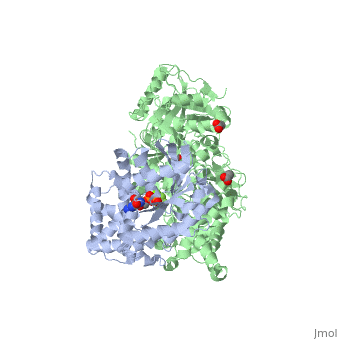PLC beta 3 Gq
Unique bidirectional interactions of Phospholipase C beta 3 with G alpha QUnique bidirectional interactions of Phospholipase C beta 3 with G alpha Q
IntroductionPhospholipase C (PLC) catalyzes the hydrolysis of phosphatidylinositol 4,5-bisphosphate [IP2] to the second messengers inositol 1,4,5-trisphosphate [IP3] and diacylglycerol [DAG] in an essential step for many physiological cascades. When the receptor is stimulated by ligand of some kind it increase exchange of guanosine diphosphate (GDP) for guanosine triphosphate (GTP) on Gαq. GTP-bound Gαq activates PLC- β3, and PLC- β3 increases up to three orders of magnitude the rate of hydrolysis of GTP by its activating G protein. This is a unique mechanism when the PLC-β3 enzyme has the ability to terminate the Gαq protein signal in addition to being activated by it.[1] [2] Structural highlightsThe Gαq subunit consists two domains, one is the GTPase domain and the other is the alpha helical domain. These domains include three regions called . consisting of N-terminal PH domain, a series of four EF hands, a catalytic TIM barrel that the X/Y linker connect its two halves and a C2 domain. PLC- β3 engages Gαq throughout three regions. First, an extended loop between the third and fourth EF hands of PLC- β3 directly supports switch residues critical for GTP hydrolysis by Gαq. Second, the region of PLC- β3 that connects the catalytic TIM barrel and the C2 domain interacts with both switches 1 and 2 of Gαq. Third, a segment composed of a helix-turn-helix at the C terminus of the C2 domain mostly located within a shallow declivity on the surface of Gαq formed by switch 2 and α3. PLC-β3 interacts with a surface on Gαq that with portions of Gα subunits needed for engagement of RGS proteins and the effector-binding region. Other effectors are known to engage the within Gα subunits. There are a large family of regulator of G protein signaling (RGS) proteins that independently accelerates the GTP hydrolysis in the .
|
| ||||||||||
ReferencesReferences
- ↑ Waldo GL, Ricks TK, Hicks SN, Cheever ML, Kawano T, Tsuboi K, Wang X, Montell C, Kozasa T, Sondek J, Harden TK. Kinetic Scaffolding Mediated by a Phospholipase C-{beta} and Gq Signaling Complex. Science. 2010 Nov 12;330(6006):974-80. Epub 2010 Oct 21. PMID:20966218 doi:10.1126/science.1193438
- ↑ Lyon AM, Tesmer JJ. Structural insights into phospholipase C-beta function. Mol Pharmacol. 2013 Oct;84(4):488-500. doi: 10.1124/mol.113.087403. Epub 2013 Jul, 23. PMID:23880553 doi:http://dx.doi.org/10.1124/mol.113.087403
